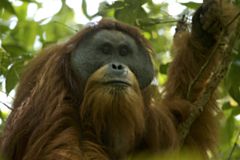Project 2591: A. Nater, M. P. Mattle-Greminger, A. Nurcahyo, M. G. Nowak, M. de Manuel, T. Desai, C. Groves, M. Pybus, T. B. Sonay, C. Roos, A. R. Lameira, S. A. Wich, J. Askew, M. Davila-Ross, G. Fredriksson, G. de Valles, F. Casals, J. Prado-Martinez, B. Goossens, E. J. Verschoor, K. S. Warren, I. Singleton, D. A. Marques, J. Pamungkas, D. Perwitasari-Farajallah, P. Rianti, A. Tuuga, I. G. Gut, M. Gut, P. Orozco-terWengel, C. P. van Schaik, J. Bertranpetit, M. Anisimova, A. Scally, T. Marques-Bonet, E. Meijaard, M. Krützen. 2017. Morphometric, Behavioral, and Genomic Evidence for a New Orangutan Species. Current Biology. 27 (22):3487-3498.e10.

Specimen: Pongo tapanuliensis (Nurcahyo, Meijaard, Nowak & Fredriksson, 2016) (unvouchered)
View: frontal view
View: frontal view
Abstract
Six extant species of non-human great apes are currently recognized: Sumatran and Bornean orangutans, eastern and western gorillas, and chimpanzees and bonobos. However, large gaps remain in our knowledge of the fine-scale variation in hominoid morphology, behavior, and genetics, and aspects of great ape taxonomy remain in flux. This is particularly true for orangutans (genus: Pongo ), the only Asian great apes, and phylogenetically our most distant relatives among extant hominids. Definitive designation of Bornean and Sumatran orangutans, P. pygmaeus (Linnaeus 1760) and P. abelii (Lesson 1827), as distinct species took place as recently as 2001. Based on morphological, behavioral and environmental data, and corroborated by population genetic analyses of 37 orangutan genomes, we show that an isolated population of the Sumatran orangutan south of Lake Toba, Batang Toru, is highly distinct from the northern Sumatran and Bornean populations. The deepest split in the evolutionary history of extant orangutans occurred ~3.38 Ma between this remnant population south of Lake Toba and those to the north, while both currently recognized species separated much later about 674 ka. A morphometric analysis based on cranio-mandibular and dental characters as well as behavioral data revealed consistent differences between individuals from Batang Toru and other extant Ponginae. Our combined analyses support a new classification of orangutans into three extant species. One of them, P. tapanuliensis, encompasses the Batang Toru population, of which fewer than 800 individuals survive.Read the article »
Article DOI: 10.1016/j.cub.2017.09.047
Project DOI: 10.7934/P2591, http://dx.doi.org/10.7934/P2591
| This project contains |
|---|
Download Project SDD File |
Currently Viewing:
MorphoBank Project 2591
MorphoBank Project 2591
- Creation Date:
12 January 2017 - Publication Date:
02 November 2017 - Media downloads: 162

Authors' Institutions ![]()
- Australian National University
- Cardiff University
- University of Cambridge
- University of St. Andrews
- Universitaet Konstanz
- Universitat Pompeu Fabra (UPF)
- Universiteit van Amsterdam (University of Amsterdam)
- University of Southern California
- University of Zurich (Universität Zürich)
- Southern Illinois University
- Sumatran Orangutan Conservation Programme
- Durham University
- Leibniz Institute for Primate Research
- Liverpool John Moores University
- University of Portsmouth
- Wellcome Trust Sanger Institute
Members
| member name | taxa |
specimens |
media |
| Matthew G Nowak Project Administrator | 1 | 2 | 3 |
| Maja Greminger Full membership | 0 | 0 | 0 |
| Michael Krützen Full membership | 0 | 0 | 0 |
| Erik Meijaard Full membership | 0 | 0 | 0 |
| Alexander Nater Full membership | 0 | 0 | 0 |
Project has no matrices defined.
Project downloads 
| type | number of downloads | Individual items downloaded (where applicable) |
| Total downloads from project | 672 | |
| Project downloads | 320 | |
| Document downloads | 190 | Additional Supplementary Material_Skull3D (64 downloads); Additional Supplementary Material_Mandible3D (94 downloads); Additional Supplementary Information (32 downloads); |
| Media downloads | 162 | M435788 (85 downloads); M435789 (40 downloads); M435790 (37 downloads); |
